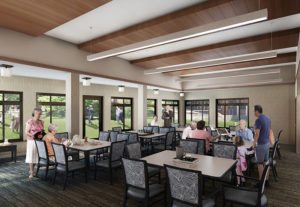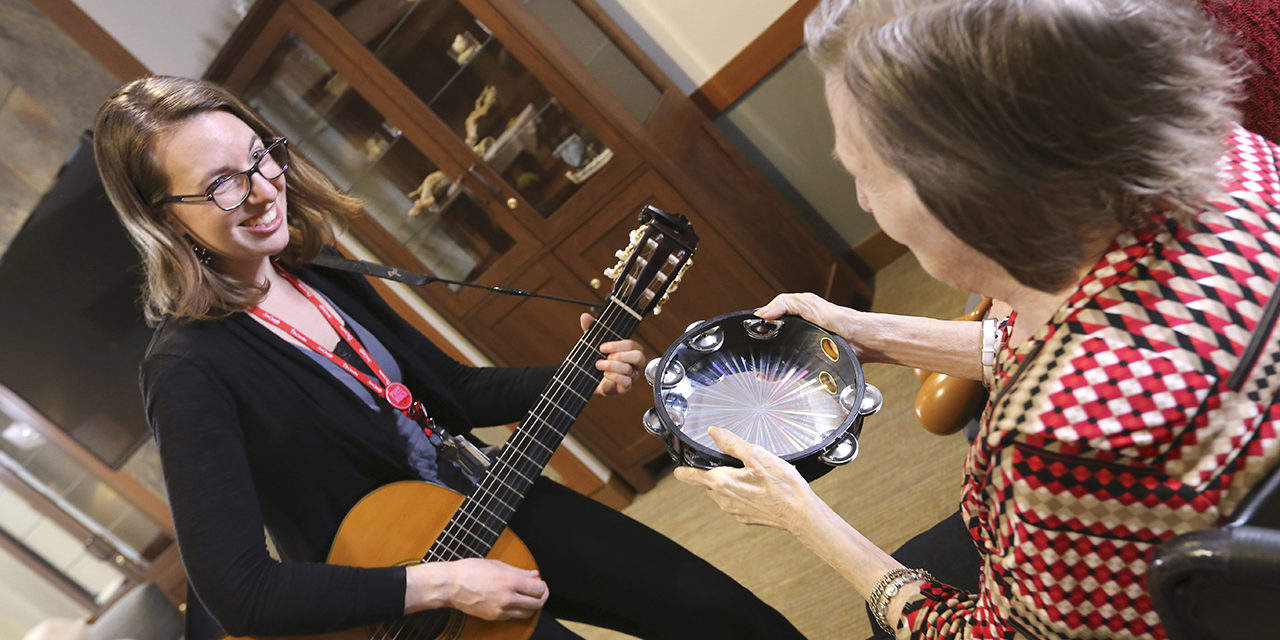The disease that robs one of memory – Alzheimer’s – also makes an indelible mark on those families who live close to it.
By Rick Romano
Tim Harrington is a prime example of Alzheimer’s lasting influence.
The son who assisted his father through the difficult journey that lasted 10 years found his own path to a new career along the way. He combined his skillset in manufacturing sales with his personal connection through family experience to forge a new vocation. As a development coordinator for the Alzheimer’s Association of Wisconsin, Tim focuses on workplace relations and advocacy.
Harrington said the experience of going through a decade of Alzheimer’s as a supportive family member led him to a rewarding career in helping others.
“It’s going to be different for everyone, even though it attacks the brain in a similar way,” Harrington said. “There’s the forgetfulness, repeating questions four or five times. My mom talks about friends noticing this more readily during social situations because when they would ask him something, he would defer to her and she was more outgoing anyway so he would benefit.
“Everyone in the early stages finds those kinds coping mechanisms.”
Harrington himself coped through his father’s decade-long slide by pitching in along with his brother to relieve his mother of constant caregiving. Getting the elder Tim out of the house was the main objective, he said, noting a comfortable refuge was found on the golf course.
“About a year and a half before he died, I could still take my dad golfing,” Harrington said. “I could drive him up to ball and point him in the right direction and he could still hit well. With his memory, he lost track of the strokes. Those were good days.”
Those days eventually led to the later stages of Alzheimer’s where home care was no longer an option.
Experiential career
Harrington now is in a paying-it-forward career where he strives to connect those who are in similar situations with the resources they need. That includes helping family, friends and others associated with those who directly suffer.
“I lived with this as a son and it never leaves you,” he said. “I look at the disease as the first part is hardest on the person who suffers, then it shifts to other members of the family who have to help them in many ways including toileting them and showering them.
“We were lucky to have a good support system, but not everyone has that.”
Harrington said only a small percentage of people reach out and get help.
“It can be very isolating,” he said, noting how his parents could no longer participate together in playing sheepshead, a favorite pastime. The isolation then is a shared experience.
When caregivers come together in a group that he addresses, he said, they share their stories and learn they are not alone. One of the real benefits is creating a sort of new community with ideas that can help them cope with their loved ones.
“You have 14 caregivers in a room who don’t know each other, and after a few months they are not only helping each other but they are having dinner together,” Harrington said. “It creates a natural support system.”
That support system helps them leave behind that feeling of helplessness that often occurs immediately after diagnosis.
“The family is given a packet of information and they only open it when they are in a crisis situation,” he said. “Every presentation I give leads to anecdotal information about real life situations that they can hear and react to in a group setting instead of reading a textbook.”
More caregivers’ views
Others say they benefit from the support given by the Alzheimer’s Association.
When Peggy Brandt was helping her late husband John confront Alzheimer’s, they went to an initial meeting where the caregivers were in one room and those with the disease in the other. She said the lively banter and laughter coming from the other room was a happy reminder that loved ones were still experiencing life in their own way.
Tony Cutraro also feels that way when Patti, his wife of 49 years and diagnosed nine years ago, speaks to her sister by phone or connects with grandchildren by computer FaceTime. After caring for her at their home for a number of years and yielding to a memory care center on Milwaukee’s East Side, Cutraro still sees “a glimmer in her eye,” during those moments.
Like Brandt, Cutraro also finds some solace in connecting with other caregivers.
“You can’t wallow in the facts that you can’t control,” he said. “Those days are gone, so it’s best to come to grips with that. You always hold out hope that something will come along because people are living longer.”
Cutraro added that he realizes that for those who face the Alzheimer’s past Patti’s lifetime, there will likely be more reasons for hope.
Brandt echoes that sentiment.
“It’s really important that we find a cure or a way to keep it from happening so soon,” she said.

Breakthroughs
Despite the current consequences of an Alzheimer’s diagnosis, here are several glimmers of hope the Alzheimer’s Association said have been reached or anticipated through research:
- National Institutes of Health (NIH) research funding has increased from between $500 and $600 million to 2.3 billion annually since 2015. As a result, scientists can work more rapidly to advance basic knowledge, explore ways to reduce risk, uncover new bio marks for early diagnosis including drug targeting and develop potential treatments.
- New PET Scan technology now is able to identify the building up of plaques and tangles associated with Alzheimer’s up to 20 years before cognitive symptoms occur.
- The SPRINT-Mind study reported that treatment of blood pressure resulted in significant reductions in the risk of mild cognitive impairment.
- The Alzheimer’s Association is leading the U.S. POINTER study designed to reduce risk for 2,000 volunteer older adults through physical exercise, healthier diet, social stimulation and self-management of heart and vascular health.
- BAN401, a drug designed to reduce the rate of cognitive decline, is moving into a phase-three trial. Phase two indicated a 30 per cent reduction in cognitive decline.
- A proposed bill has been introduced in Washington to allow those diagnosed with Alzheimer’s and dementia who are younger than 60 to access support programs provided by the Older Americans Act. That bill is in committee and is expected to be addressed beginning the coming weeks after Congress reconvenes.
The Community Response
With an estimated 850 residents living with Alzheimer’s and an estimated 2500 non-professional caregivers for them, Wauwatosa is fully involved in the effort to address the disease.
The city committed to help residents and others learn about Alzheimer’s, and local senior living campuses have been expanding their memory care capabilities.
Education
The Alzheimer’s Association will give three one-hour presentations in September and October in the Civic Center’s lower level meeting room. They include “Understanding Alzheimer’s and Dementia” on Sept. 12, “The Ten Warning Signs of Dementia” on Sept. 25, and “Healthy Living for Your Body and Brain” on Oct. 16. All three presentations begin at 7 p.m.
Health Department Director Laura Conklin and Public Health Specialist Carmen Pangilian said the department’s health assessments have revealed an increase in dementia-related diseases including Alzheimer’s.
“We hear from people when they get the diagnosis and you now know you are the caregiver,” Conklin said. “No one prepares you for that. The presentations help meet that need.”
“We want the community to know they can come to us for help in learning more about a variety of health issues,” Pangilian said.
Expanding facilities
In senior living, St. Camillus opened a new North Residence in spring of 2018. CEO Kevin Schwab, in a prepared statement, described the facility as a comprehensive residential environment that provides various therapies, socialization and cognitive stimulation.
 He also noted his organization’s efforts to weave education into the care.
He also noted his organization’s efforts to weave education into the care.
“Besides the facilities dedicated to care for individuals diagnosed with either Alzheimer’s Disease or another disease associated with dementia, we partnered with the Alzheimer’s Association to offer specialized training for staff to become Certified Dementia Care Generalists,” he said.
“We also have begun to train staff utilizing the Virtual Dementia Tour tool kit which enables caregivers to experience for themselves the physical and mental challenges those with dementia face and use the experience to provide better person-centered care. Besides these, we have also become aware of the need to support family members of individuals that suffer from Alzheimer’s or dementia by offering support groups and educational programs to help people cope with this terrible disease.”
The Lutheran Home is in the process of expanding its memory care capabilities from 40 to 72 residences. While CEO Scott McFadden said great care is being taken to design a user-friendly environment designed specifically for cognitively challenged residents, he noted, “Our residents are ok. After a while, they flourish because of the programs that we have in place for them. So, we are going to focus our programming on the caregivers – the husband, the wives, the children and other significant others.”
That approach seems to be at least partially driven by The Lutheran Home’s association with former Gov. Martin Schreiber, whose wife Elaine is a resident. Schreiber’s book “My Two Elaines,” describes the challenging life of a caregiver. In fact, Schreiber’s lead contribution and a challenge match gift have helped make the expansion – known as Elaine’s Place – possible.
McFadden said his own personal experience seeing his mother-in-law suffer from Alzheimer’s fuels his professional goals.
“It’s a distinctive experience,” McFadden said. “We have found that there is more demand for care than availability. For me, this is really important.”
Facts & Figures
Alzheimer’s is a degenerative brain disease of unknown cause that is the most common form of dementia, that usually starts in late middle age or in old age, and results in progressive memory loss, impaired thinking, disorientation, and changes in personality and mood. In a technical sense, it is marked by the presence of amyloid plaques and neurofibrillary tangles.
Here are just a few facts provided by the Alzheimer’s Association:
- Alzheimer’s is the sixth leading cause of death in the U.S., and those deaths have increased 145 per cent between 2000 and 2017.
- Alzheimer’s or another form of dementia kills one of every three seniors, more than cancer and prostate cancer combined.
- Today, 5.8 million Americans are living with Alzheimer’s and that number is expected to increase to 14 million by 2050.
Essential information
While research progress is being made toward understanding and managing Alzheimer’s, Tim Harrington said people should know all current available options including support groups and care options.
To connect with the local Alzheimer’s Association – which this summer has consolidated into one statewide organization with a local home base at the Alzheimer’s Association of Wisconsin, 620 S. 76th St., Suite 160 in West Allis. Also find information at www.facebook.com/alzgreaterwi or www.alz.org/wi.





